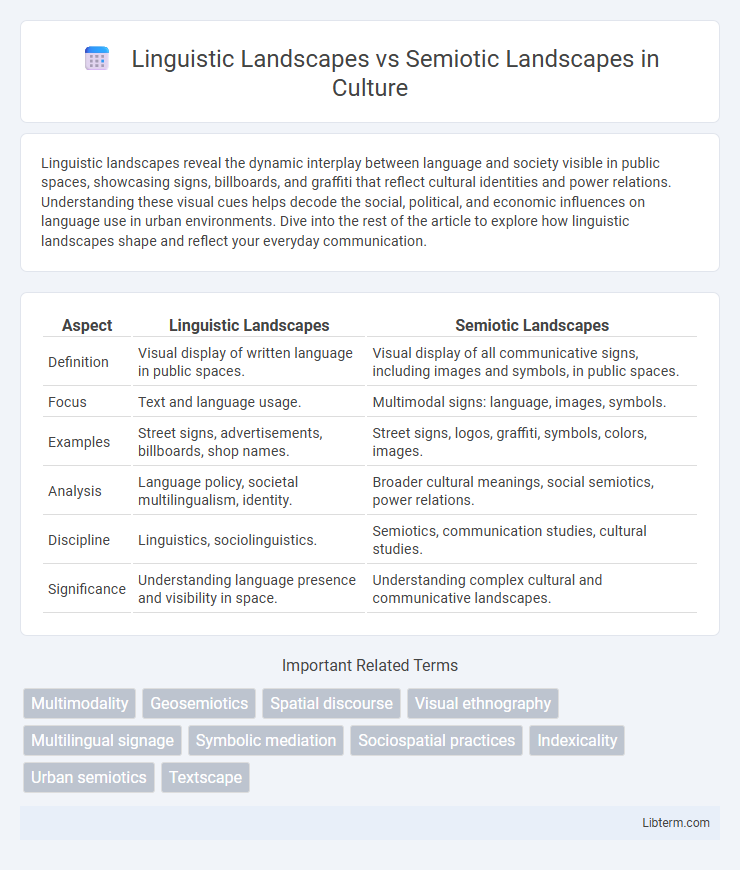Linguistic landscapes reveal the dynamic interplay between language and society visible in public spaces, showcasing signs, billboards, and graffiti that reflect cultural identities and power relations. Understanding these visual cues helps decode the social, political, and economic influences on language use in urban environments. Dive into the rest of the article to explore how linguistic landscapes shape and reflect your everyday communication.
Table of Comparison
| Aspect | Linguistic Landscapes | Semiotic Landscapes |
|---|---|---|
| Definition | Visual display of written language in public spaces. | Visual display of all communicative signs, including images and symbols, in public spaces. |
| Focus | Text and language usage. | Multimodal signs: language, images, symbols. |
| Examples | Street signs, advertisements, billboards, shop names. | Street signs, logos, graffiti, symbols, colors, images. |
| Analysis | Language policy, societal multilingualism, identity. | Broader cultural meanings, social semiotics, power relations. |
| Discipline | Linguistics, sociolinguistics. | Semiotics, communication studies, cultural studies. |
| Significance | Understanding language presence and visibility in space. | Understanding complex cultural and communicative landscapes. |
Introduction to Linguistic and Semiotic Landscapes
Linguistic landscapes analyze the visible use of language in public spaces, focusing on signs, billboards, and written texts to reveal societal language patterns and power dynamics. Semiotic landscapes expand this concept by incorporating not only linguistic elements but also visual symbols, images, and spatial arrangements, emphasizing the broader communication and meaning-making processes within cultural and social environments. Understanding both landscapes provides critical insights into how language and signs shape identity, place, and social interaction in multilingual and multicultural contexts.
Defining Linguistic Landscapes
Linguistic landscapes refer to the visible display of written language in public spaces, such as signs, billboards, and street names, which reflect the sociolinguistic dynamics of a particular area. This concept captures how language use in public signage reveals identity, power relations, and cultural diversity within urban and rural environments. By analyzing linguistic landscapes, researchers gain insights into language policies, multilingualism, and community identities embedded in spatial communication.
What are Semiotic Landscapes?
Semiotic landscapes encompass the study of all visible signs and symbols in an environment, including non-linguistic elements such as images, colors, and spatial arrangements, which convey meaning beyond just written or spoken language. These landscapes analyze how various signs interact to shape cultural, social, and ideological messages within public spaces. Understanding semiotic landscapes reveals the complex interplay of communication modes that contribute to place identity and social dynamics.
Key Differences Between Linguistic and Semiotic Landscapes
Linguistic landscapes emphasize the presence and function of written language in public spaces, focusing on how text conveys meaning, identity, and power. Semiotic landscapes encompass a broader range of signs, including images, symbols, and other non-verbal elements, analyzing how these diverse signs collectively communicate cultural and social messages. The key difference lies in linguistic landscapes' exclusive attention to language, while semiotic landscapes integrate multiple sign modalities for a comprehensive interpretation of public communication.
Theoretical Frameworks in Landscape Studies
Linguistic landscapes analyze the presence and function of written language in public spaces, emphasizing multilingualism, language policies, and sociolinguistic identities within urban and cultural settings. Semiotic landscapes expand this scope by integrating non-verbal signs, symbols, and visual elements, providing a comprehensive theoretical framework that blends sociolinguistics, cultural geography, and semiotics to decode meaning-making processes in landscapes. This interdisciplinary approach facilitates understanding of how language and other semiotic resources co-construct social realities and power dynamics in everyday environments.
Methodologies for Analyzing Landscapes
Methodologies for analyzing linguistic landscapes often involve systematic data collection of textual elements from public signage, followed by quantitative and qualitative content analysis to explore language presence, usage, and power dynamics. Semiotic landscape analysis employs multimodal approaches, integrating visual, spatial, and symbolic sign interpretations to decode cultural meanings and social interactions embedded in environmental texts. Combining ethnographic observation with digital mapping tools enhances the depth and accuracy of both linguistic and semiotic landscape studies.
Case Studies: Urban Examples
Urban case studies of linguistic landscapes reveal multilingual signage reflecting cultural diversity and language dominance in public spaces, highlighting sociolinguistic dynamics. Semiotic landscapes extend beyond language to include symbols, images, and spatial arrangement, showcasing how urban environments convey identity, power, and social relations. Examples such as New York City's street signs and public art demonstrate the interplay between linguistic presence and semiotic expressions shaping urban meaning-making.
The Role of Multimodality in Semiotic Landscapes
Multimodality plays a crucial role in semiotic landscapes by integrating diverse modes of communication such as images, texts, colors, and spatial arrangements to convey complex meanings beyond verbal language alone. Unlike linguistic landscapes, which primarily emphasize written language in public spaces, semiotic landscapes encompass a broader spectrum of signs and symbols that interact dynamically to shape social and cultural interpretations. This multimodal assemblage enables a richer, more nuanced understanding of place identity and power relations embedded in urban environments.
Impacts on Identity and Social Meaning
Linguistic landscapes, featuring visible language use in public spaces such as signs and advertisements, strongly shape community identity by reflecting and reinforcing social language hierarchies and power relations. Semiotic landscapes expand beyond language to include symbols, colors, and images that convey cultural meanings, influencing social identity by embedding collective beliefs and values into the physical environment. Both landscapes impact social meaning by negotiating group membership, cultural inclusion, and exclusion, ultimately shaping how individuals and communities perceive themselves and others in multicultural contexts.
Future Directions in Landscape Research
Future directions in landscape research emphasize integrating digital semiotics with traditional linguistic landscapes to capture evolving multimodal communication forms. Advancements in geospatial technologies and AI-driven image analysis enable more dynamic and large-scale studies of semiotic landscapes, tracking real-time cultural and linguistic shifts. Researchers aim to develop interdisciplinary frameworks combining sociolinguistics, urban studies, and visual analytics for comprehensive landscape interpretation and planning.
Linguistic Landscapes Infographic

 libterm.com
libterm.com